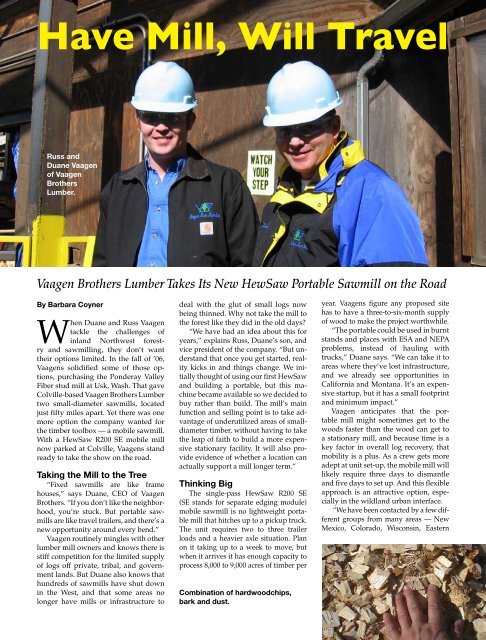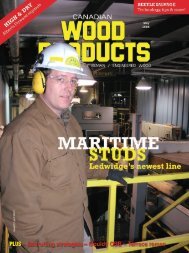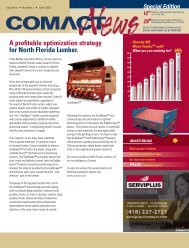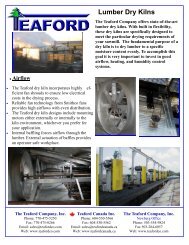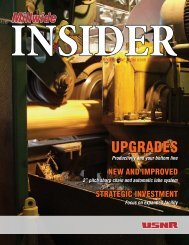Have Mill, Will Travel - Wood Products Online Expo
Have Mill, Will Travel - Wood Products Online Expo
Have Mill, Will Travel - Wood Products Online Expo
Create successful ePaper yourself
Turn your PDF publications into a flip-book with our unique Google optimized e-Paper software.
<strong>Have</strong> <strong>Mill</strong>, <strong>Will</strong> <strong>Travel</strong><br />
Russ and<br />
Duane Vaagen<br />
of Vaagen<br />
Brothers<br />
Lumber.<br />
Vaagen Brothers Lumber Takes Its New HewSaw Portable Sawmill on the Road<br />
By Barbara Coyner<br />
When Duane and Russ Vaagen<br />
tackle the challenges of<br />
inland Northwest forestry<br />
and sawmilling, they don’t want<br />
their options limited. In the fall of ’06,<br />
Vaagens solidified some of those options,<br />
purchasing the Ponderay Valley<br />
Fiber stud mill at Usk, Wash. That gave<br />
Colville-based Vaagen Brothers Lumber<br />
two small-diameter sawmills, located<br />
just fifty miles apart. Yet there was one<br />
more option the company wanted for<br />
the timber toolbox — a mobile sawmill.<br />
With a HewSaw R200 SE mobile mill<br />
now parked at Colville, Vaagens stand<br />
ready to take the show on the road.<br />
Taking the <strong>Mill</strong> to the Tree<br />
“Fixed sawmills are like frame<br />
houses,” says Duane, CEO of Vaagen<br />
Brothers. “If you don’t like the neighborhood,<br />
you’re stuck. But portable sawmills<br />
are like travel trailers, and there’s a<br />
new opportunity around every bend.”<br />
Vaagen routinely mingles with other<br />
lumber mill owners and knows there is<br />
stiff competition for the limited supply<br />
of logs off private, tribal, and government<br />
lands. But Duane also knows that<br />
hundreds of sawmills have shut down<br />
in the West, and that some areas no<br />
longer have mills or infrastructure to<br />
deal with the glut of small logs now<br />
being thinned. Why not take the mill to<br />
the forest like they did in the old days<br />
“We have had an idea about this for<br />
years,” explains Russ, Duane’s son, and<br />
vice president of the company. “But understand<br />
that once you get started, reality<br />
kicks in and things change. We initially<br />
thought of using our first HewSaw<br />
and building a portable, but this machine<br />
became available so we decided to<br />
buy rather than build. The mill’s main<br />
function and selling point is to take advantage<br />
of underutilized areas of smalldiameter<br />
timber, without having to take<br />
the leap of faith to build a more expensive<br />
stationary facility. It will also provide<br />
evidence of whether a location can<br />
actually support a mill longer term.”<br />
Thinking Big<br />
The single-pass HewSaw R200 SE<br />
(SE stands for separate edging module)<br />
mobile sawmill is no lightweight portable<br />
mill that hitches up to a pickup truck.<br />
The unit requires two to three trailer<br />
loads and a heavier axle situation. Plan<br />
on it taking up to a week to move, but<br />
when it arrives it has enough capacity to<br />
process 8,000 to 9,000 acres of timber per<br />
Combination of hardwoodchips,<br />
bark and dust.<br />
year. Vaagens figure any proposed site<br />
has to have a three-to-six-month supply<br />
of wood to make the project worthwhile.<br />
“The portable could be used in burnt<br />
stands and places with ESA and NEPA<br />
problems, instead of hauling with<br />
trucks,” Duane says. “We can take it to<br />
areas where they’ve lost infrastructure,<br />
and we already see opportunities in<br />
California and Montana. It’s an expensive<br />
startup, but it has a small footprint<br />
and minimum impact.”<br />
Vaagen anticipates that the portable<br />
mill might sometimes get to the<br />
woods faster than the wood can get to<br />
a stationary mill, and because time is a<br />
key factor in overall log recovery, that<br />
mobility is a plus. As a crew gets more<br />
adept at unit set-up, the mobile mill will<br />
likely require three days to dismantle<br />
and five days to set up. And this flexible<br />
approach is an attractive option, especially<br />
in the wildland urban interface.<br />
“We have been contacted by a few different<br />
groups from many areas — New<br />
Mexico, Colorado, Wisconsin, Eastern<br />
TimberWest — May/June 2007 29
The mill doesn’t scan, so sorting<br />
is important. Duane intends to run<br />
logs with 4.5” to 7” tops, although<br />
the mill can handle larger.<br />
Oregon, Western Montana, and others,”<br />
Russ says. “We would like to keep it relatively<br />
close, to get started, while we learn<br />
the process of running the mill. We also<br />
have the capacity for drying and planing<br />
lumber in Colville, which will be helpful,<br />
especially in the beginning. Once we get<br />
the model running and proven, we will<br />
look for opportunities rather than distances.<br />
Many of the underutilized smalldiameter<br />
timber supplies are far away,<br />
but most are likely in the West.”<br />
Rolling the Dice<br />
Duane concedes that labor, log storage,<br />
and electric rates all create challenges<br />
and make cost estimates dicey. “The<br />
labor issue is key, and ideally it would<br />
be good to have five to seven people on a<br />
shift, with trained operators available to<br />
move with the mill.” He calculates that<br />
electricity costs compare to a large grinder<br />
operation. “The potential is there, but<br />
there is risk as well as reward,” he adds.<br />
Another issue is finding contractors to<br />
do the necessary logging to keep supply<br />
at around 20 loads per day. “If an area has<br />
lost its mill, it’s also lost its contractors,”<br />
Duane points out. And because the mill<br />
is strictly a sawmill, drying and planing<br />
are separate issues to be resolved, as<br />
well. In New Mexico, air-drying could<br />
work well, he says, adding, “These are<br />
all logistics we don’t know. But when a<br />
community wants us, we’ll be there.”<br />
Optimistic Risk Taking<br />
Although the future remains to be<br />
seen, the family-owned company has<br />
traveled over uncertain paths before. In<br />
1989, the Colville mill came on-line with<br />
the first HewSaw in the Northwest. It<br />
was risky then, and it is risky now, according<br />
to Russ, the fourth generation<br />
to get involved since Vaagen Brothers<br />
started in the 50’s.<br />
“People said we’d go broke, milling<br />
small logs,” Russ says. But the high<br />
speed and efficiency of that first HewSaw<br />
kept the Colville facility humming with<br />
dimensional lumber and good quality<br />
chips. The company bought a second<br />
HewSaw, an R200, in 1995 and overlapped<br />
it with the first saw, retiring the<br />
first saw in 1997. The Usk mill, complete<br />
with what Russ terms a “monster<br />
lumber sorter,” boasts a HewSaw R200<br />
PLUS, a speed demon in the world of<br />
hew wood sawing technology.<br />
“The saw is similar in technology to<br />
our machines at Colville and Usk,” Russ<br />
says. “The machine does not scan and set<br />
for size, so sorting will be important. We<br />
plan on running logs from 4.5” top to 7”<br />
top. We can go larger, but we will probably<br />
choose not to, due to log costs and<br />
competition. The capacity of the machine<br />
is somewhere between 50 and 70 million<br />
board feet in lumber from two shifts annually.<br />
The most critical issues will be<br />
feeding the proper logs to the machine<br />
and handling lumber on the outfeed.”<br />
The portable sawmill has a capacity<br />
of 50 to 70 million board feet<br />
a year running two shifts.<br />
New Zealand Purchase<br />
Ed Mayer of Veisto Group, which<br />
markets the HewSaw brand internationally,<br />
has watched Vaagens progress,<br />
noting, “Duane Vaagen was one of the<br />
first companies to bring the HewSaw<br />
technology into North America in the<br />
1980’s. Over the years, Vaagen Brothers<br />
really made their HewSaw perform<br />
well and set worldwide small log processing<br />
standards. Being lasting, successful<br />
HewSaw customers, they kept<br />
up with HewSaw news from around<br />
the world. Duane learned about the<br />
mobile HewSaw unit in the 1990’s, and<br />
that one had been sent to New Zealand,<br />
but was shut down and sitting idle.<br />
Convinced that this mobile concept has<br />
a huge opportunity to work in North<br />
America, he made a deal to purchase<br />
this unit from the New Zealand company.<br />
Once delivered, Vaagen Brothers set<br />
up the unit for testing and showcasing<br />
at their Colville sawmill site.”<br />
Mayer says that HewSaw was originally<br />
known for portability, having operated<br />
mobile hewing machines throughout<br />
Finland early in its existence.<br />
“This was their main business until<br />
sawmillers got keen on the machine<br />
technology and requested to buy just<br />
the machines,” Mayer says. “The machine<br />
evolved over forty plus years to be<br />
more of a high production breakdown<br />
machine to be installed in a sawmill.<br />
Nevertheless, the single pass design still<br />
lends itself to be a perfect mobile unit<br />
that can be easily dismantled, transported<br />
and set up again from site to site to<br />
process small logs very efficiently.”<br />
Bringing it All Together<br />
Once the mobile mill is retrofitted<br />
to American measurement standards,<br />
Vaagens can compete in the wood products<br />
game much more flexibly. With<br />
the arsenal of HewSaws, the company<br />
processes timber from about 25,000<br />
acres apiece, annually, in the Usk and<br />
Colville plants, with the Colville planer<br />
accepting half the green studs from Usk,<br />
and the rest going to Merritt Brothers<br />
Lumber in Athol. The Colville mill,<br />
known for its mammoth portal crane,<br />
can sort huge amounts of small-diameter<br />
logs, and features a co-generation<br />
plant, as well. While the new portable<br />
mill can’t keep quite the pace of the two<br />
fixed mills, it has its advantages.<br />
“The best feature is obvious — it’s<br />
portable,” Russ says. “We can move it<br />
relatively easily from one area to another<br />
when resources and opportunity<br />
dictate those movements. We see it as<br />
an R&D machine that will allow us to<br />
see if the log supply and infrastructure<br />
could support a stationary sawmill<br />
longer term. The limitations are that the<br />
machine is not as efficient as a stationary<br />
sawmill, and it also doesn’t have<br />
the flexibility of many mills. We think<br />
these limitations are dwarfed by the<br />
opportunity of its mobility.”<br />
30 May/June 2007 — TimberWest


